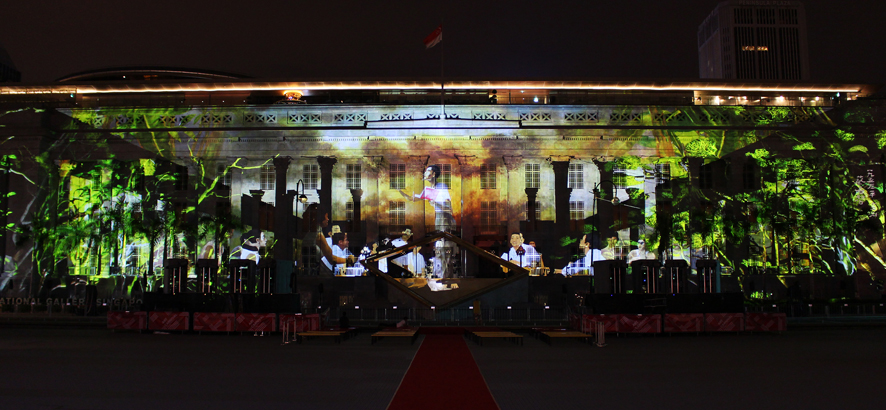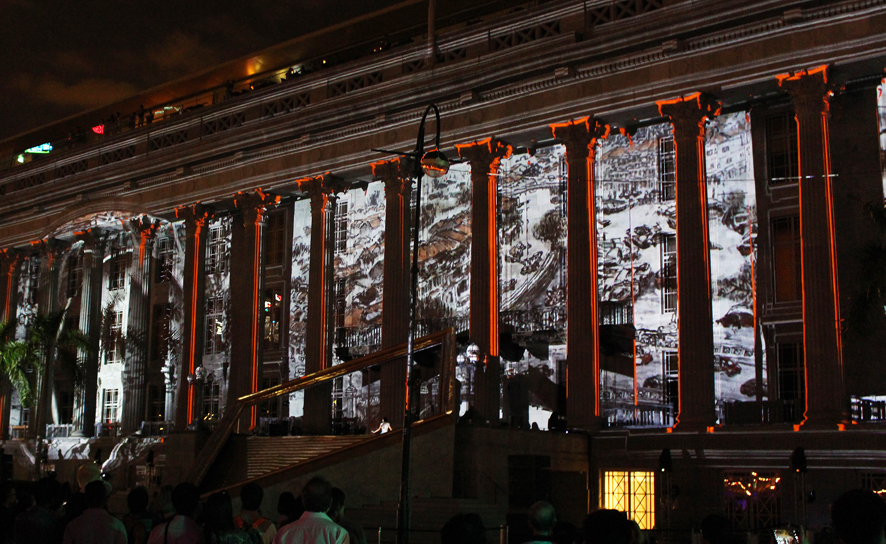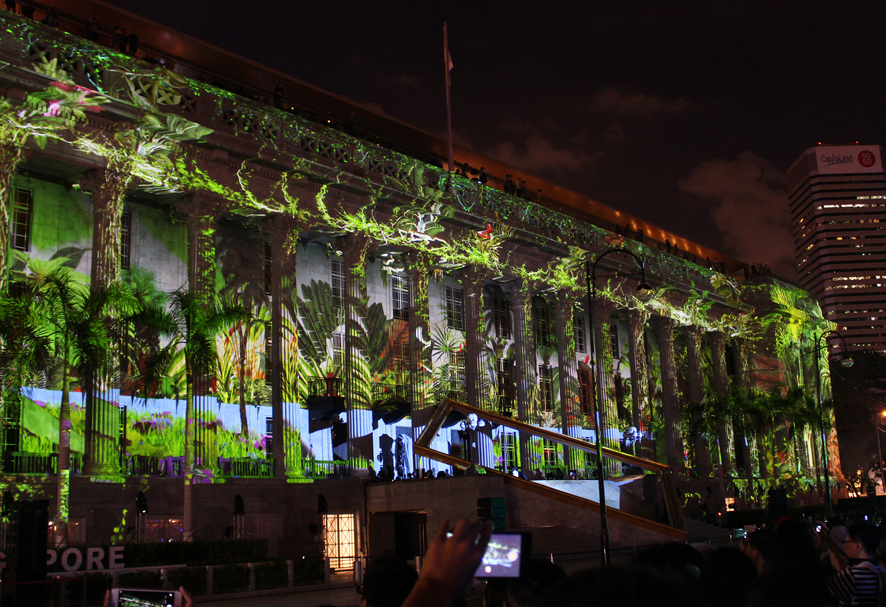The space spans a staggering 690,000 sq ft and is a landmark to be proud of and one that is capable of competing with other artistic icons around in the world.
‘Art Carnival at the Padang’ was a 3 day festival which marked the official opening of the gallery. The concept was for visitors to experience the rich heritage of Singapore and Southeast Asian art with a weekend of interactive art installations, community art workshops and artisanal treats. This was to be topped off by a grand light and sound display set against the backdrop of the newly transformed National Gallery Singapore and inspired by the art within its walls.
‘Share The Hope Façade Show’ was the commissioned eight-minute visually spectacular show to be projected on the façade of the building, inspired by artworks from the gallery. In order to articulate the light show, the gallery appointed Ctrl Fre@k as the Technical Consultant. Wee Cheng Low, a partner of the show design company explained: “Our role was to work with the creative team to help them realise their ideas for the project. The projection brief given by the Video Projection Director, Milosh Luczynski, was to specify a playback system that was able to handle high-resolution content, as well as having the ability to help realise a seamless projection image. As the façade is slightly complicated, with there being columns infront of walls, we knew shadows would be an issue. Therefore the playback system needed to have features and functions to help us mend these shadow areas with images.”
After understanding the requirements, Wee and his team began to research different media servers to find out if any existing products available on the market met the criteria. To begin with the team explored the route of a 2D warping and masking solution that was until they entered into conversations with visual specialist, Green Hippo, which recommended a 3D solution using its SHAPE application software.
“SHAPE works in a 3D environment, which allowed us to map our content onto the gallery building quite simply. It allowed us to easily align the 3D model to the real object, as the software worked out the projector placement based on the input points we chose on the gallery,” continued Wee. A total of 14 Christie Boxer 4K30 3,0000 lumen, high-resolution, three-DLP projectors – mounted on Layher tower structures – were specified by Stephane Beve, Video Projection Technical Director & 3D Supervisor for the projection mapping of the building. Multiple projectors projected onto specific areas of the façade and projectors were placed at different angles in relation to the façade. “SHAPE simulated the projector position in the 3D world once it had collected the data from the user and it then sent out the content based on these positions,” said Wee. “Without SHAPE, we would have required a lot more time to slice, mask and warp the content, if we had been working in a 2D environment set-up.”
There were many challenges during this project with time and shadows being the two main areas of concern. Programming and alignment could only take place in the evening, but being monsoon season it was very rainy and windy. The other problem was the shadows cast by the pillars of the building, but using SHAPE the team could re-align or warp any of the content and not have to re-render because of shadows.
The SHAPE application ran on laptops – so it was portable during the alignment stage – connected to the four Green Hippo Hippotizer V4 Boreals and one Hippotizer V4 Karst. The five media servers shared the workload preventing the high-resolution content from sending the system into overdrive. The video content showcased paintings from collections within the National Gallery using animation. It also highlighted the old Colonial style architecture, when the building was known as City Hall during the British rule.
Obviously, the exquisite visuals continue inside the gallery too, not only in the art itself – which comprises over 8,000 works from the 19th and 20th centuries in all media, including painting, sculpture, printmaking, photography and video – but the stunning architecture of the building and the various different spaces including the auditorium, the city hall verandah, the coleman deck, the glass room and the supreme court terrace. All are to be marvelled at.
Among a crowded footprint of entertainment hubs, the National Gallery has definitely made its mark since the opening just over a month ago. With little known about Southeast Asian art, it’s likely the gallery will be as popular as its counterparts in cities such as New York, Paris, Shanghai, Mumbai and London.
Credits:
Video Projection Director: Milosh Luczynski
Video Projection Technical Director 3D Supervisor: Stephan Beve
Video Projection Production Manager: Luz Mando
Video System Designer and programmer: Wee Cheng Low (Ctrl Fre@k)
Technical Production Company: Ctrl Fre@k


